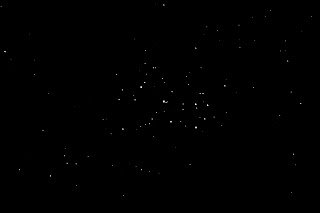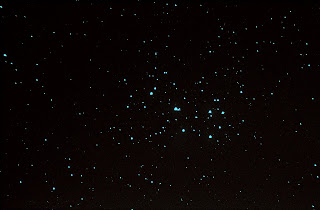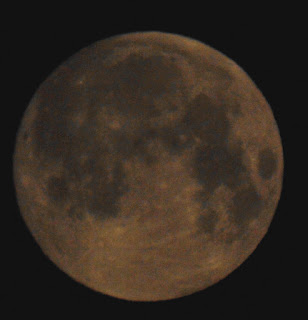February 27th 0900 GMT
February 27th 0810 GMT
It was rather cold but clear when I checked out the Moon. It
was just past last quarter phase and I snapped it with my DSLR at ISO400 300mm
focal length and 1/200th second exposure.
Unfortunately, I could not get the right contrast.
February 26th 2250 GMT
February 26th 2200 GMT
I took a few frames of Leo using my DSLR at 300mm focal length, ISO 6400 and 10 seconds exposure. Some mist ruined the photo but I managed to get the main star patterns.
February 25th 2030 GMT
February 25th 1840 GMT
I saw Mercury low near the western horizon. It was too low
to catch in a telescope. Binoculars showed it as a disc but I could not detect
the phase. I tried the DSLR on it, more in hope than expectancy. I needed to remove a lot of chromatic aberration.
February 25th 1000 GMT
February 24th 2200 GMT
I returned outside with my DSLR and used it at 300mm focal
length, ISO 6400 and 2 seconds exposure.
First was the Orion Great Nebula (M42).
After an OK-ish result from a single frame, I revisited the stacked image to extract more detail.
Then there were 27 frames of the Pleaides:
Again, I tried an alternative process to show more stars and some nebulousity, although the result was not so sharp.
The Beehive (M44) was out of focus but looked OK when I shrunk it.
February 24th 2000 GMT
February 19th 0625 GMT
February 18th 2000 GMT
Things did not go to plan! I attempted lunar close-ups with
my Mak and Bresser Electronic Eyepiece and I had PC crashes and clouds to contend
with. I managed two imaging runs aimed at Plato and Copernicus/Kepler.
February 18th 1740 GMT
It was not long after sunset and I knew that Mercury was in
the evening sky. Superficially, the sky appeared clear but, on checking the
area near sunset, I could not see any sign of the planet. The Moon, however,
was different. It was near full and Tycho’s rays were dominating the moonscape.
I could also see Plato, Copernicus and Kepler.
February 17th 2110 GMT
February 16th 2110 GMT
Despite the weather forecast, there was a lot of haze so I
snapped the Moon early using the same approach as the evening before.
February 15th
I was out and about with only binoculars. The sky was very
clear, so I took a look at the Moon, which was well clear of the horizon. I
could clearly see Clavius and Tycho’s ray system was already prominent. Despite
the daylight, the contrast was very good.
February 15th 1115 GMT
February 14th 2110 GMT
I took some shots of the Moon with my DSLR only. I used
300mm focal length, 1/2000 second exposure and ISO 100.
I was very pleasantly surprised to end up with nine images in focus. I stacked them using Microsoft ICE, then finished in GIMP. I removed the red and blue channels and adjusted colour, curves, brightness and contrast to end up with a decent result.
February 14th 1350 GMT
The Sun appeared quiet in hydrogen alpha light again but I
saw some minor signs of activity.
February 13th 2110 GMT
After an underwhelming couple of lunar shoots two days before, I increased the exposure time to 1/160 second, with ISO 100 and 1.54m focal length. It seemed to work better and I stacked 110 frames.February 11th 2120 GMT
Unfortunately, the result was disappointing, despite having stacked 70 images.
February 11th 1845 GMT
I did another shot of the Moon with my DSLR using the same
settings as the evening before.
February 11th 1510 GMT
The Sun was quiet again in hydrogen alpha light.
A second attempt at processing revealed a little more detail.
February 10th 2120 GMT
I snapped the Moon with my DSLR at 300mm focal length, ISO
100 and 1/1000 second exposure.
February 7th 0940 GMT
February 2nd 0940 GMT
There was snow and ice around, so I snapped the Sun in
hydrogen alpha light from indoors. It was the most blank and featureless Sun I'd seen but the Big Bear images showed little, too,
































No comments:
Post a Comment